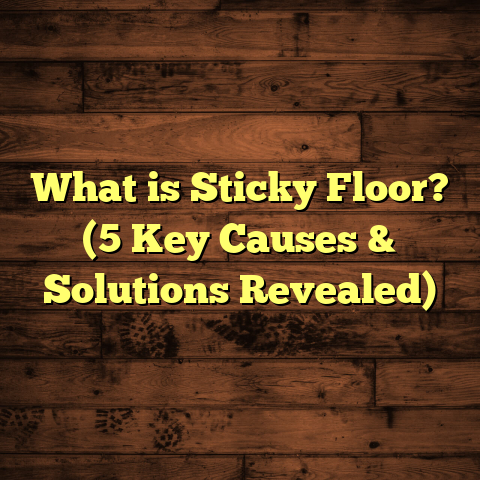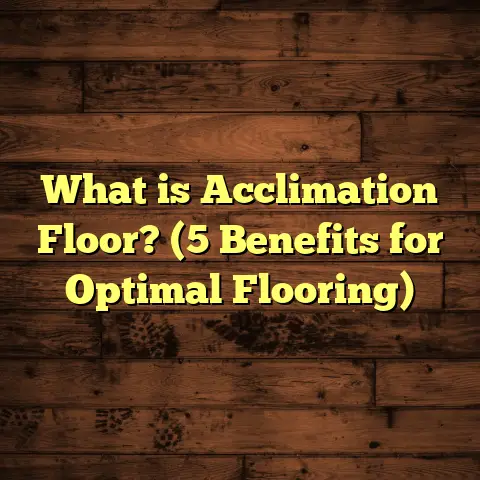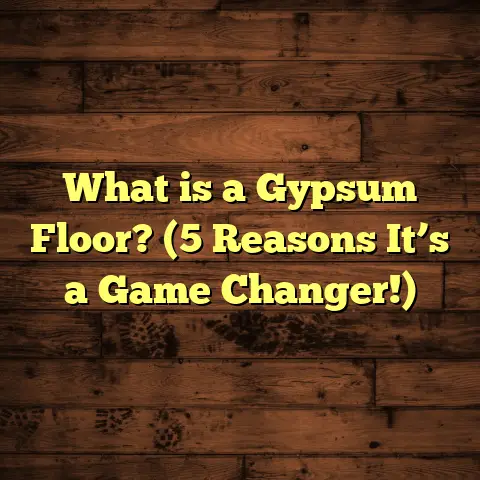What is Vertical Displacement in Flooring? (5 Key Impacts Revealed)
Eco-friendly flooring options have become a significant part of how I approach my flooring projects these days. I’ve always been interested in materials that aren’t just beautiful but also kind to the environment. Whether it’s bamboo, reclaimed wood, cork, or recycled vinyl, choosing green materials has helped me align my work with sustainable living. But one thing I quickly learned on my journey is that even the most environmentally responsible choice can fall short if the floor itself isn’t stable. That’s where understanding vertical displacement in flooring becomes essential.
You might wonder, what exactly is this vertical displacement? And why should it matter to you if you’re just planning to lay down some new floors or replace an old carpet? Well, it’s a topic that many overlook, but it has far-reaching effects on safety, aesthetics, durability, and cost. Over the years, I’ve faced many situations where addressing vertical displacement made all the difference in delivering a floor that lasts.
So let’s take a walk through what vertical displacement means in flooring, how it impacts your project, and what you can do to prevent or fix it. I’ll also share some stories and data from my experience, including how I use tools like FloorTally for cost estimation and project planning.
What is Vertical Displacement in Flooring?
At its core, vertical displacement refers to the height difference between two adjacent sections of a floor. Imagine walking across a room and feeling one plank or tile sit higher or lower than the one next to it. This unevenness is vertical displacement. It’s not just about the floor “looking” uneven; it’s about parts of your floor physically moving up or down relative to each other.
This movement can be subtle — sometimes just a fraction of an inch — or more pronounced. Even small differences can cause problems over time.
Why does it happen? Floors are made up of different materials laid over subfloors and sometimes resting on joists or concrete slabs. These layers can expand, contract, settle, or shift based on environmental conditions like moisture and temperature, structural changes in the building, or how the floor was installed.
In my early days as a flooring contractor, I encountered vertical displacement mostly as an afterthought when clients complained about “bumpy” floors. One client with an eco-friendly bamboo floor thought their new floor was defective because they could feel slight ridges when walking barefoot. After inspecting, I found that unevenness in the subfloor was causing those planks to sit higher or lower.
That was my first real lesson: even the best materials need a level playing field underneath.
Why Vertical Displacement Matters: Five Key Impacts
Let me share five major impacts vertical displacement has on flooring performance and why you shouldn’t ignore it.
1. Safety: Trip Hazards and Injury Risks
Have you ever tripped over a tiny bump on the floor? It’s annoying at best and dangerous at worst. Vertical displacement creates uneven surfaces that can easily catch toes or destabilize footing.
The National Safety Council estimates millions of falls occur annually in homes, many caused by uneven flooring surfaces. In one project with an elderly homeowner, I noticed vertical displacement near doorways where warped planks were raised about ⅛ inch (3 mm) compared to adjacent floors. Simply fixing this greatly reduced her fall risk.
Even small vertical differences — as little as ¼ inch — can be enough to cause trips. For families with kids or seniors, this risk can’t be overstated.
2. Accelerated Wear and Material Damage
When parts of your floor sit unevenly, they don’t share loading forces evenly. This puts stress on certain boards or tiles and leads to cracking, warping, joint separation, or finish wear.
I once installed engineered hardwood in a home located in an area with high seasonal humidity swings. Without proper subfloor leveling and moisture control, planks began cupping and gapping within months due to uneven expansion and contraction.
Similarly, tiles installed over uneven concrete slabs often crack because grout joints are stressed unevenly by vertical displacement.
3. Aesthetic Disruption and Comfort Issues
A flat floor looks clean and feels comfortable underfoot—especially if you like walking barefoot like I do. Vertical displacement disrupts this smoothness, creating ridges or dips that are visible or felt when walking.
One client chose cork flooring for its softness and eco-friendliness but complained about “waves” underfoot shortly after installation. Measuring revealed vertical displacement caused by insufficient subfloor preparation.
This problem may also reduce the perceived value of your home since buyers often notice uneven floors during inspections.
4. Cost Implications: Installation and Repairs
Fixing vertical displacement after installation costs more than preventing it upfront. Repair work can include sanding hardwood floors unevenly, replacing warped planks or tiles, or leveling subfloors after damage has occurred—all labor-intensive and expensive.
In projects where I anticipated potential unevenness based on subfloor condition or material choice, I used FloorTally to factor extra labor and waste into my budget estimates. This helped me present clients with realistic costs and avoid surprises later.
5. Reduced Flooring Lifespan
Floors with ongoing vertical displacement issues tend to fail sooner due to constant movement stressing joints and finishes unevenly.
With vinyl plank installations I did in moisture-prone basements, ignoring vertical displacement caused edges to curl and gaps to develop within a year in some spots.
What Causes Vertical Displacement?
Understanding what causes vertical displacement can help you prevent it before it starts.
Moisture-Induced Movement
Wood naturally expands and contracts with humidity changes. If this movement isn’t properly accounted for during installation, planks can rise or sink unevenly.
In coastal regions or humid climates where moisture fluctuates regularly, I always recommend moisture barriers beneath wood floors to limit swelling or shrinking.
Subfloor Irregularities
If your subfloor isn’t flat—maybe it has bumps, dips, cracks, or settling—your finished floor will reflect those imperfections.
Concrete subfloors might develop cracks over time; wooden subfloors can warp or sag between joists if not properly supported.
On one job for a renovated farmhouse, an uneven plywood subfloor caused noticeable vertical displacement after installation until we leveled it with a self-leveling compound.
Installation Errors
Improper installation techniques like failing to acclimate wood planks before laying them down or improperly spacing joints contribute heavily to vertical displacement.
I once inspected a laminate floor where the installer didn’t leave expansion gaps around edges — this led to buckling and raised edges shortly after completion.
Structural Settling
Older buildings often settle unevenly over decades. This movement shifts floor heights in different areas unpredictably.
In a century-old home renovation I worked on recently, foundation repairs were necessary before addressing floor leveling issues caused by structural settling.
How to Detect and Measure Vertical Displacement
Being able to detect vertical displacement early helps prevent bigger problems later on. Here are some methods I use regularly:
- Straightedge or Long Level: Placing a long straightedge or carpenter’s level across suspect areas reveals gaps underneath or rocking spots.
- Laser Levels: These provide highly accurate measurements of floor flatness over large areas.
- Barefoot Walk Test: Sometimes simply walking barefoot over the floor lets you feel subtle bumps and dips.
- Digital Sensors / Floor Profilers: Some advanced devices measure height differences down to fractions of a millimeter for professional projects.
When I worked on a commercial project with polished concrete floors covering several thousand square feet, laser scanning was invaluable for creating a detailed map of low/high spots before grinding began.
How I Address Vertical Displacement in My Projects
After years of hands-on experience, here’s how I manage vertical displacement from start to finish:
Subfloor Preparation is Non-negotiable
I always inspect subfloors thoroughly before laying down any finish material. Uneven spots get fixed with self-leveling compounds (for concrete) or sanding (for wood).
If the subfloor is too damaged or unstable, replacing it can be necessary rather than patching over problems.
Smart Material Choices
Some flooring materials tolerate slight unevenness better:
- Vinyl Planks: Flexible and forgiving of minor bumps.
- Engineered Hardwood: More dimensionally stable than solid wood.
- Carpet: Naturally cushions minor irregularities.
- Tile: Requires very flat surfaces; otherwise prone to cracking.
Matching material choice with subfloor conditions helps reduce future vertical displacement risks.
Proper Acclimation & Moisture Barriers
For wood floors especially, acclimating material on-site allows them to adjust to humidity before installation — preventing later swelling/shrinking.
I also install vapor barriers under floors in moist environments like basements to keep moisture out from below.
Installation Best Practices
Leaving proper expansion gaps around edges and staggering plank joints avoids localized buckling.
Using recommended adhesives and fasteners ensures planks stay securely fastened without shifting vertically over time.
Maintenance & Early Detection
I encourage clients to monitor floors seasonally for signs of warping or ridges developing so minor issues can be fixed before they worsen.
Using FloorTally for Accurate Cost Estimation
Estimating costs accurately is one of my biggest challenges when dealing with potential vertical displacement issues. Unexpected subfloor repairs can blow budgets fast.
FloorTally has become an indispensable tool for me here. It lets me:
- Input local labor rates reflecting actual market costs
- Include waste factors for extra material needed when leveling subfloors
- Compare different material choices side by side with their price impacts
- Visualize total project costs upfront to set clear client expectations
For example, on a recent bamboo flooring project with an uneven subfloor discovered after demolition, FloorTally helped me quickly recalculate budget including self-leveling compound costs and extra labor hours for prepping the base layer.
This transparency saved both me and the client time and guesswork during negotiations.
Case Study: Fixing Vertical Displacement in Hardwood Flooring
Let me tell you about one memorable project that taught me a lot about handling vertical displacement effectively…
A client had installed solid oak flooring themselves but started noticing noticeable bumps
and ridges forming within six months. They contacted me frustrated because they worried
the wood was defective or poor quality.
After inspection, I found several issues:
- The subfloor plywood was uneven with dips exceeding ¼ inch in places.
- No moisture barrier was installed under the floor.
- The wood hadn’t been acclimated before installation.
- Expansion gaps were insufficient around room edges causing buckling in some areas.
The solution involved removing affected planks carefully rather than ripping up the entire floor. Then we:
- Leveled the subfloor using self-leveling compound.
- Installed a vapor barrier to block moisture from below.
- Allowed wood planks to acclimate on-site for 4 days.
- Reinstalled planks leaving correct expansion gaps.
- Sanded the entire floor evenly before finishing with durable polyurethane coating.
The result? A smooth, level hardwood floor without those pesky bumps returning for years afterward. The client was thrilled!
More Data & Insights on Vertical Displacement
To give you some numbers:
- Industry standards suggest flooring surfaces should not exceed 3/16 inch (about 4.7 mm) deviation over 10 feet for hardwood and laminate floors.
- Tile installations require even tighter tolerances—no more than 1/8 inch (3 mm) deviation over 10 feet.
- According to studies from the National Wood Flooring Association (NWFA), improper subfloor preparation is responsible for over 60% of flooring failures related to unevenness.
- Moisture-related swelling accounts for approximately 25% of vertical displacement cases in wood flooring annually in humid climates.
- Self-leveling compounds typically add around $1-$3 per square foot to project costs but reduce future repair expenses significantly.
Understanding these benchmarks helps me guide clients towards realistic expectations without cutting corners on prep work.
How You Can Prevent Vertical Displacement Before Installing Floors
Here’s some practical advice you can follow whether you’re DIY-ing or hiring pros:
- Always verify your subfloor is level using long levels or straightedges before starting.
- Acclimate wood flooring indoors at least 48 hours prior to installation.
- Use moisture vapor barriers when installing over concrete slabs or damp areas.
- Leave proper expansion gaps around room edges as recommended by manufacturers.
- Choose materials suited for your climate — engineered wood handles humidity better than solid hardwood.
- Schedule regular inspections after installation to catch early signs of shifting or warping.
- If unsure about leveling techniques yourself, hire professionals who can perform tests like laser scanning or moisture readings beforehand.
My Personal Takeaway on Vertical Displacement
After seeing both success stories and tough lessons regarding uneven floors across hundreds of projects — here’s what I’ve learned:
Vertical displacement isn’t just a cosmetic nuisance; it affects safety
and can shorten your floor’s life dramatically if not addressed properly early
on. Taking the time upfront to prep your surfaces correctly saves money
and grief later—and keeps your eco-friendly floors looking great longer.
Using technology like FloorTally helps me take guesswork out of budgeting
and planning for these contingencies so clients get clear picture from day one.
If you’re considering new flooring soon—whether bamboo, hardwood, tile,
or vinyl—talk openly with your installer about how they plan to address
vertical displacement risks based on your home’s unique conditions.
FAQs About Vertical Displacement in Flooring
Q: Can vertical displacement develop after installation?
A: Yes! Changes in humidity, temperature swings, structural settling, or water damage can cause floors that were once level to develop vertical differences over time.
Q: How much vertical displacement is acceptable?
A: For hardwood/laminate floors, deviations should generally not exceed 3/16 inch over 10 feet; for tile, it’s usually tighter at 1/8 inch over 10 feet. Anything above that risks damage or safety issues.
Q: Are some flooring types more resistant to vertical displacement?
A: Yes—vinyl planks and carpet are more forgiving of minor unevenness due to flexibility; engineered hardwood is more dimensionally stable than solid wood; tiles require very flat surfaces.
Q: Can I fix vertical displacement myself?
A: Minor issues might be fixed by sanding high spots or filling low spots if you have experience; larger problems often require professional leveling using specific compounds or replacing parts of the subfloor.
Wrapping Up My Thoughts on Vertical Displacement
Understanding vertical displacement has been one of those eye-opening moments
in my flooring career—helping me deliver safer, longer-lasting floors every time.
It mixes technical know-how with practical experience—whether measuring levels
with traditional tools or using modern laser scanning methods—plus smart budgeting
with tools like FloorTally that keep projects realistic financially too.
So next time you think about flooring options—don’t just pick your favorite eco-friendly
material based on looks alone—think about what’s underneath too! A flat foundation means your
floor will stand tall for years without those annoying bumps getting in your way.
Have you experienced issues with uneven floors before? Or are you about to start a
project and want advice on preventing these problems? Feel free to ask—I’m here
to help make sure your floors feel as good as they look!





